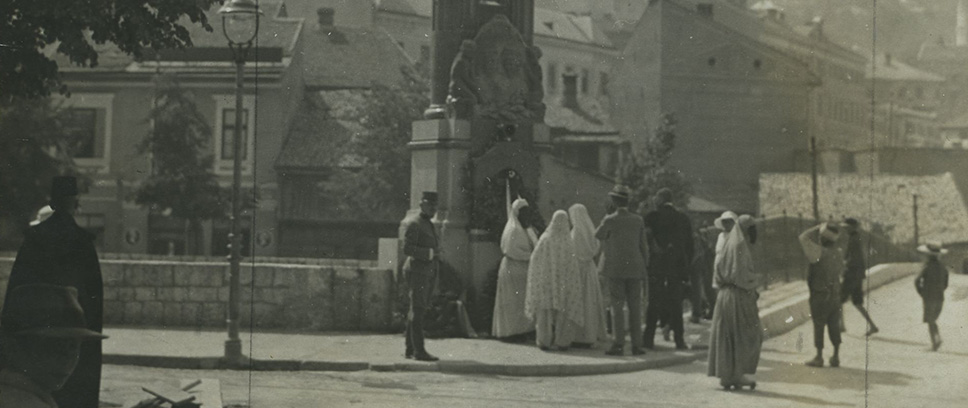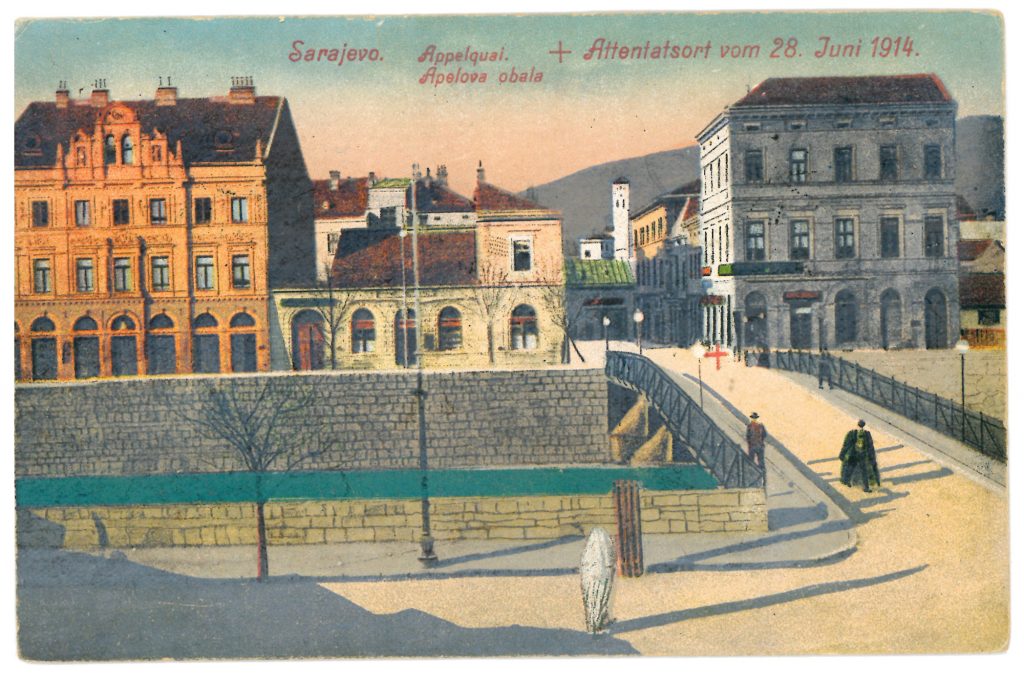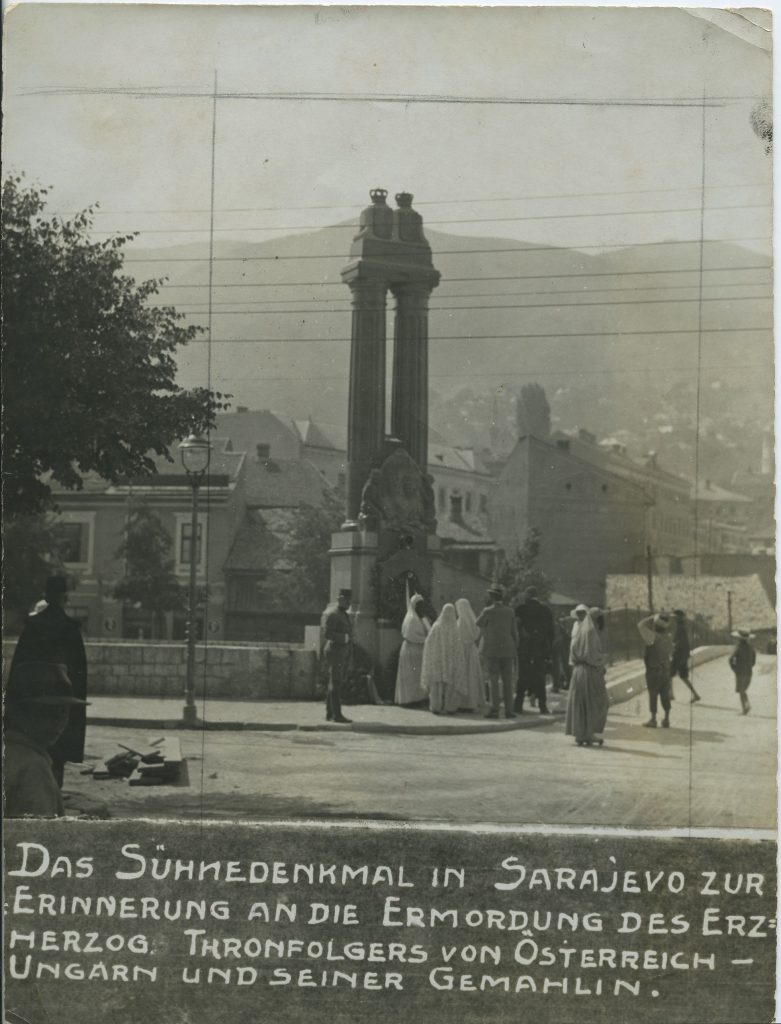
What´s that for? Memorial plaque for Gavrilo Princip
Michael Ilg | 28 June 2023
What does the Deutsches Historisches Museum have to do with the memorial plaque for Gavrilo Princip and the assassination in Sarajevo? This plaque, stolen by the National Socialists, was displayed during the Second World War in the Zeughaus in Berlin, Unter den Linden, as a war trophy until 1946, when it was returned to Yugoslavia. How this came about is described by the historian Michael Ilg in this article.
On 28 June 1914, 19-year-old Gavrilo Princip shot and killed the heir to the Austrian throne, Franz Ferdinand, and his wife Sophie, Duchess of Hohenberg, during their visit in Sarajevo. The attack triggered the so-called July Crisis and led to the outbreak of the First World War.
A short time after the assault an initial commemorative plaque was installed at the location of the assassination. It read:
“28 VI 1914
At this intersection died a martyr’s death by murderer’s hand the heir to the throne Archduke Franz Ferdinand and his consort Duchess Sophie Hohenberg”

In 1916, when the First World War was raging, the city administration of Sarajevo already commissioned the Hungarian artist Jenő Bory (1879-1959) to design a memorial that could be seen from afar. It was consecrated on 28 June 1917.
The artist designed a tall granite twin-pillar mounted on an altar-like pedestal decorated with a bronze relief and portraits of the royal couple. It was crowned with the united emblem of Austria-Hungary. However, the so-called “Atonement Memorial” only existed until 1918, when it was dismantled. The bronze applications are now found in the Art Gallery of Bosnia-Herzegovina and the Museum of the City of Sarajevo. The stone remains of the memorial were given to a stonemason.

As a result of the lost war, the Austro-Hungarian Empire ceased to exist. Bosnia-Herzegovina became part of the newly founded Kingdom of Serbia, Croatia and Slovenia, which in 1929 evolved into the Kingdom of Yugoslavia. The reconstruction of the site began with the renaming of the Latin Bridge in Sarajevo. It was now called Princip Bridge and only regained its original name in 1992.
Gavrilo Princip, who was venerated as a freedom fighter in the newly founded first state of the south Slavs, was honoured with a memorial plaque, which was inaugurated on 2 February 1930 on the occasion of the 15th anniversary of the death of the conspirators Danilo Ilić, Miško Jovanović and Veljko Čubrilović. They were co-organisers and accomplices in the assassination.
The plaque was inscribed in Serbo-Croatian:
“At this historical site Gavrilo Princip brought liberty on 15/28 Vivodan.”
It was not by accident that the murder of Franz Ferdinand and his wife took place on 28 June. The so-called “Vidovdan” (Saint Vitus Day) commemorates the day of the Battle of Kosovo on the Kosovo (Blackbird) Field in 1389. In the mid-19th century it was institutionalised by the Serbian Orthodox Church and has been celebrated as a holiday ever since. The day represents the Serbian struggle for liberty against Ottoman suppression. Gavrilo Princip and his comrades-in-arms deliberately chose this holiday as the day of liberation from the Austro-Hungarian Empire.
Without declaring war, the Axis powers invaded the Kingdom of Yugoslavia on 6 April 1941. The kingdom was divided up among the invading parties after Yugoslavia’s unconditional surrender. When the Nazi forces entered Sarajevo, the memorial plaque was removed on 17 April 1941 by so-called “Volksdeutsche” – ethnic Germans – under the command of a certain Lieutenant Mittelmann. The event was recorded in the media and exploited for propaganda. The whole procedure was documented by a photographer from the photography company of Heinrich Hoffmann, Adolf Hitler’s personal photographer, and extensively reported on in German news programmes.

United Archives / Pincornelly
“Ethnic Germans” from Bosnia-Herzegovina gave the plaque to the Wehrmacht to be delivered to Hitler as a present. Three days later it was presented to him on his birthday in the Führer headquarters in East Prussia. During the Second World War the plaque was displayed in the Berlin Zeughaus as a war trophy.
After the war it was generally believed that the memorial plaque had been irrevocably lost. The Austrian newspaper postulated in 2013:
“Hitler had the memorial plaque displayed in the Berlin Zeughaus (now Deutsches Historisches Museum Berlin), which was severely damaged by Allied bombing. From then on every trace of the plaque disappeared.”1
This was not exactly the case. The marble plaque had been handed over to a representative of the Yugoslav military mission on 6 November 1946. In the immediate post-war period the Zeughaus settlement agency or the former direction of the Zeughaus was ordered to hand over stolen war booty found in its collections to the relevant authorities. Java Avšić, head of the Yugoslavian military commission, confirmed the receipt of the memorial plaque in writing on 11 November 1946.
After it was returned to Yugoslavia, the marble plaque could have been brought to its original site in Sarajevo. But the 1930 plaque’s inscription conveyed a view of Yugoslav history that no longer conformed to the concept of post-war socialist Yugoslavia. New memorial plaques with revised inscriptions had been installed at the site of the assassination in 1945 and again in 1952. They, too, were not to be the last ones and were removed in 1992 at the beginning of the siege of Sarajevo. In 2002 a new plaque with an apolitical inscription was placed at the site. What happened to the original plaque from 1930 after it was returned in 1946 remains a puzzle.
1 https://www.derstandard.at/story/1385169347506/des-fuehrers-epochale-rache (last accessed: 14.06.2023)
Michael IlgMichael Ilg worked at the Deutsches Historisches Museum as an academic trainee in the area of exhibitions. He studied history, focusing on South Eastern European history and Jewish history, at the Universities of Augsburg, Prague and Poznań. |